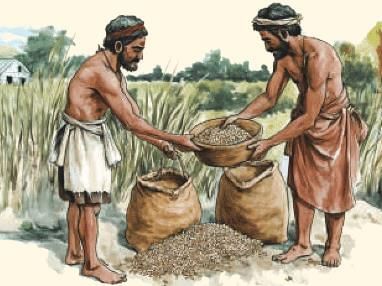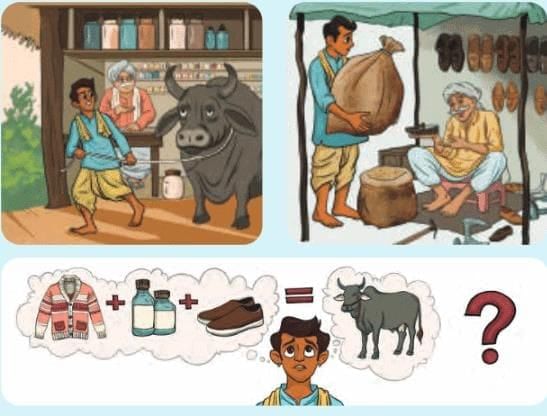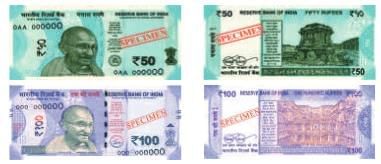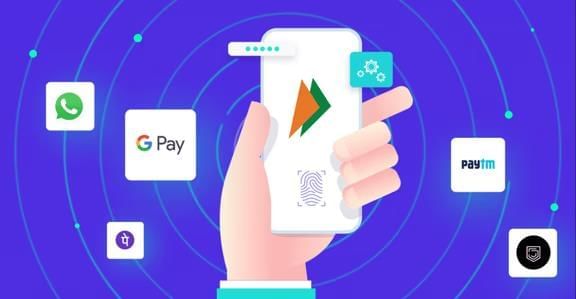Class 7 Social Science Chapter 11 Very Short Answer Questions - From Barter to Money
Q1: What is the barter system?
Ans: The barter system was the exchange of goods and services without using money.
Q2: What was the main drawback of the barter system?
Ans: A major problem with the barter system was the double coincidence of wants, which means that for a trade to happen, both parties had to want exactly what the other person was offering. This made exchanges difficult and inefficient.
Q3: What is meant by ‘money’?
Ans: Money is a common tool used for buying and selling goods and services.
Functions of Money
Q4: Who was John Maynard Keynes?
Ans: John Maynard Keynes was an economist who said that money connects the present to the future by helping us save and spend later.
Q5: Why did the barter system become less efficient over time?
Ans: The barter system became inefficient due to problems like the difficulty of finding someone who wanted what you offered and the inability to divide goods like cattle.
Q6: How does money solve the problems of the barter system?
Ans: Money solves these problems by being portable, divisible, durable, and a standard measure of value.
Q7: What is the ‘double coincidence of wants’?
Ans: Double coincidence of wants means both parties in a trade must want what the other offers, which is rare and difficult.
Q8: How is money more useful than goods in the barter system?
Ans: Money is portable, divisible, and accepted by everyone, unlike goods which may not be easily traded or split.
Q9: What is the importance of the medium of exchange function of money?
Ans: The medium of exchange function allows money to be used universally for buying and selling goods and services.
Q10: How does money serve as a store of value?
Ans: Money serves as a store of value by allowing people to save it and use it later, unlike perishable goods like wheat.
Q11: What does "common denomination" mean in the context of money?
Ans: Common denomination means money is used to measure the value of goods, making it easy to compare prices.
Q12: What is a "standard of deferred payment"?
Ans: A standard of deferred payment means money can be used to make payments later, as in buying goods on credit.
Q13: What are "cowrie shells" in relation to money?
Ans: Cowrie shells were used as money in ancient times in different parts of the world, including India.
Cowrie Shells
Q14: What are "Rai stones"?
Ans: Rai stones were large stone discs used as money in Micronesia, symbolizing wealth.
Q15: Why were coins important in the history of money?
Ans: Coins were important because they provided a standardized, easily recognizable form of money made from precious metals like gold and silver.
Q16: What were "kārshāpanas" in ancient India?
Ans: Kārshāpanas were ancient Indian coins made from precious metals, used for transactions in the Mauryan Empire.
Q17: What was the role of the Roman coins in India?
Ans: Roman coins found in Tamil Nadu and Kerala show that India had strong maritime trade connections with the Roman Empire.
Q18: When was paper currency introduced in India?
Ans: Paper currency was introduced in India in the late 18th century by banks like the Bank of Bengal and Bank of Bombay.
Q19: What are modern banknotes in India made of?
Ans: Modern Indian banknotes are made of cotton paper, with special features like raised marks for the visually impaired.
Q20: What does the ₹ symbol represent, and who designed it?
Ans: The ₹ symbol represents the Indian Rupee and was designed by Udaya Kumar in 2010, combining Devanagari and Roman characters.
Q21: What is digital money?
Ans: Digital money refers to intangible money that exists electronically, such as through mobile payments or bank transfers.
Q22: How are QR codes used in modern payments?
Ans: QR codes are used for digital payments, allowing customers to pay directly from their bank accounts using their phones.
Q23: What is the Unified Payments Interface (UPI)?
Ans: UPI (Unified Payments Interface) is a digital payment system that enables instant transfer of money between bank accounts using smartphones.
Q24: How did the introduction of paper currency help trade?
Ans: Paper currency made it easier to carry large sums of money for trade and reduced the need to transport heavy coins.
Q25: Give one example of a modern barter system in India.
Ans: The Junbeel Mela in Assam is a modern example where people exchange roots, vegetables, and handmade goods for food items like rice cakes.
|
23 videos|204 docs|12 tests
|
FAQs on Class 7 Social Science Chapter 11 Very Short Answer Questions - From Barter to Money
| 1. What is barter, and how does it work? |  |
| 2. What are the limitations of the barter system? |  |
| 3. How did money evolve from the barter system? |  |
| 4. What are the different forms of money? |  |
| 5. Why is money considered a better medium of exchange than barter? |  |



























